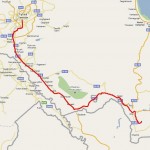First part can be found here, or you can read both together.
 After meeting the Azeris at Yeraskh things got even more chilly and so did the weather. We enjoyed our candy bars and started climbing the mountains to finally get to Noravank.
After meeting the Azeris at Yeraskh things got even more chilly and so did the weather. We enjoyed our candy bars and started climbing the mountains to finally get to Noravank.
At the final intersection we turned right across the small bridge to the narrow road that is perhaps my most favorite road section to ride in the south. It is a worn tarmac secondary road through a narrow gorge the color of the sun, and while the colors of the scenery resemble those of the Barrens in World of Warcraft (especially around summertime), the blooming trees, the wide expanse of the sky and the light tarmac all add fantastic bright shades, making the road a lot more like fantasy than any zone in World of Warcraft can be.
In Noravank it was already unpleasantly cold and windy. We parked in the small parking lot, locked the handlebar and headed to the churches.
Architect Momik’s masterpieces were magnificent and beautiful as ever!
I insist that the crosses on the following photo signify the number of people who have died falling down the narrow stairs with no handrail. The crosses on each level signify the number of people who fell down the particular stair on that level for the given day. After the day is over, the priest registers the deaths in his statistics journal and carefully wipes the crosses using his Holy Armenian Apostolic Sandpaper. As we can see, higher stairs cause more deaths. I understand that this was Momik’s Evil Plan of Taking Over the World by slow and systematic kills over the centuries. Resistance is Futile!!
Sometimes the sandpaper does not wipe the crosses very well, and the priest has to swap the stones with cleaner ones from the other side of the church!
This is a very awesome illustration of Mary, Jesus Christ and two Angels (I think the one at the left is St. Gabriel) posing together.
After observing the churches and taking photos, we took a rest at the nearby cafe and warmed ourselves up with some tea. There was a heated discussion at the next table where two priests were explaining to some fellows that there is no such a thing as an Azerbaijani nation. Despite the scientific arguments, it sounded pretty odd after our recent encounter.
After a few minutes of walking, we realized that every minute spent at Noravank meant the way back was going to be colder. We headed back to Yerevan. The section from Noravank to Yeraskh was immensely cold, but after Yeraskh the air got warmer. Riding over 140km/h along the Most Boring Highway of Armenia (MBHA, aka M2), I was thinking about launching an awareness campaign for saving the innocent lives taken away by the absent railing of the narrow stairs.
First part can be found here, or you can read both together.
